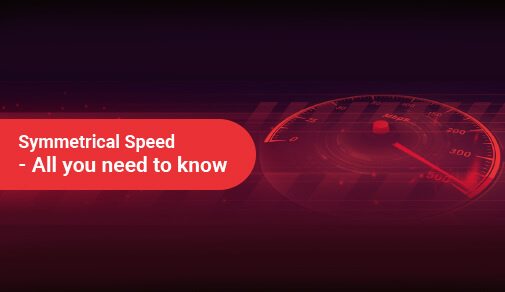Symmetrical Speed - All you need to know
Wednesday, Mar 31, 2021 · 3 minutes


INTERNET SPEED
Wednesday, Mar 31, 2021 · 3 minutes
It's likely you're unaware, but when an internet plan advertises its speed, it almost always just mentions the download speed. The upload speed can be somewhat different from the download speed, and an asymmetrical plan is one in which the upload speed is lower than the download speed. A symmetrical plan is one in which the upload and download rates are the same.
Symmetrical links are just as they sound like: they have the same download and upload rates. For example, a 500/500 Mbps fibre internet link offers download and upload speeds of 500 Mbps. An asymmetrical connection, on the other hand, does not have the same download/upload rates as a symmetrical connection. 60/3, for example, denotes a download speed of 60 Mbps and an upload speed of 3 Mbps.
##BlogVASBanner##
If you test your Internet speed at home, you'll find that your upload speeds are usually a fraction of your download speeds. An asymmetrical relation is what this is called. In an office setting where bandwidth is versatile, an asymmetrical connection is typically the best choice. FTTC and FTTP circuits are examples of asymmetrical connections. You can get fast download speeds with these types of connections, with upload speeds being about 10% of the download speeds. Asymmetrical networks often have the drawback of being congested, which means that your Internet speed is directly proportional to the amount of traffic in your city.
Most of us have managed to get by with upload speeds of less than 50 Mbps. Is symmetrical internet even worth it if we've managed to get by without fast upload speeds so far? You probably don't need symmetrical internet if you're just browsing Facebook, forwarding emails to your nieces and nephews, or searching Google for the latest sports scores. We think symmetrical internet is a huge plus if you’re one of these types of people:
50

The New Social: How High-Speed Internet is Redefining 'Quality Time' with Friends and Family
Read more135

How ACT SmartWi-Fi is Redefining Home Internet in 2025: The Age of AI-Powered Seamless Connectivity
Read more75

From Bandwidth to Intelligence: How AI Is Redefining Business Demands from ISPs
Read more
A referral link has been sent to your friend.
Once your friend completes their installation, you'll receive a notification about a 25% discount on your next bill
![]() Please wait while we redirect you
Please wait while we redirect you

![]() One of our representatives will reach out to you shortly
One of our representatives will reach out to you shortly

One of our representatives will reach out to your shortly
![]() Please wait while we redirect you
Please wait while we redirect you

Please enter your registered phone number to proceed

Please enter correct OTP to proceed


Dear customer you are successfully subscribed
Please wait while we redirect you

Your ACT Shield subscription has been successfully deactivated

Dear user, Your account doesn't have an active subscription

Dear customer Entertainment pack is already activated.
Please wait while we redirect you